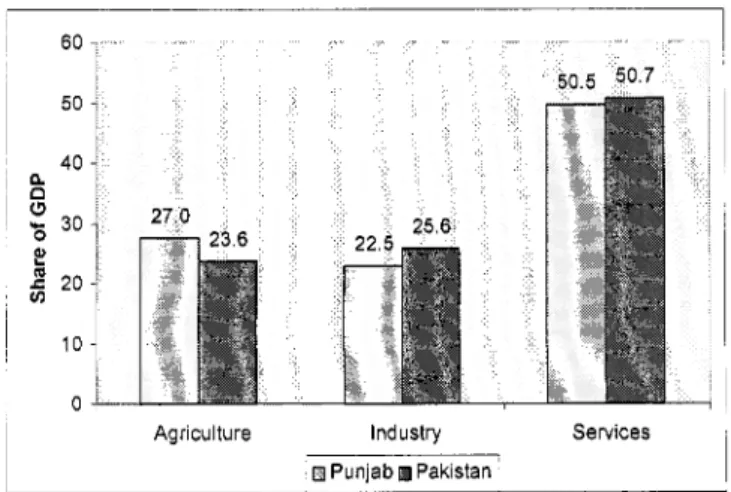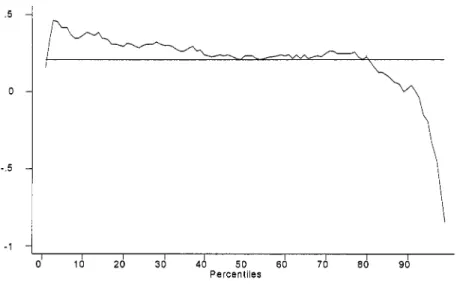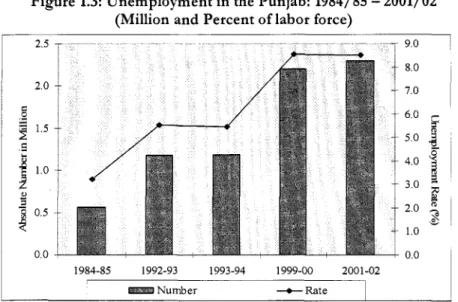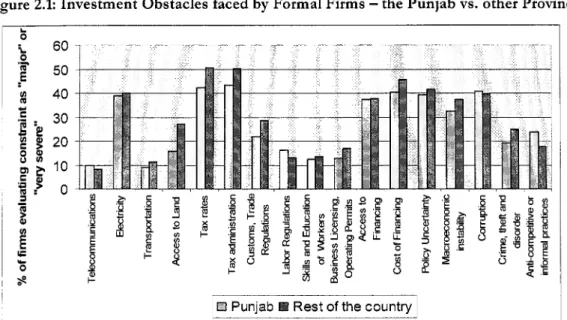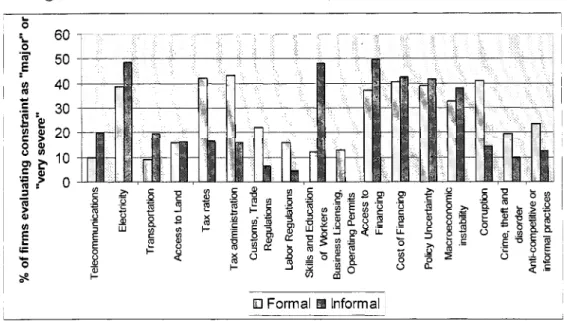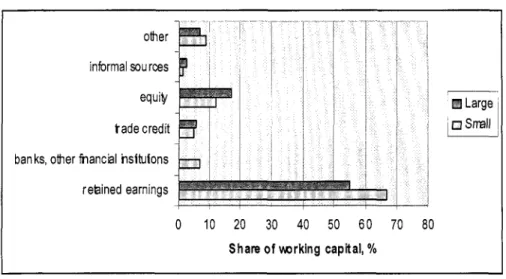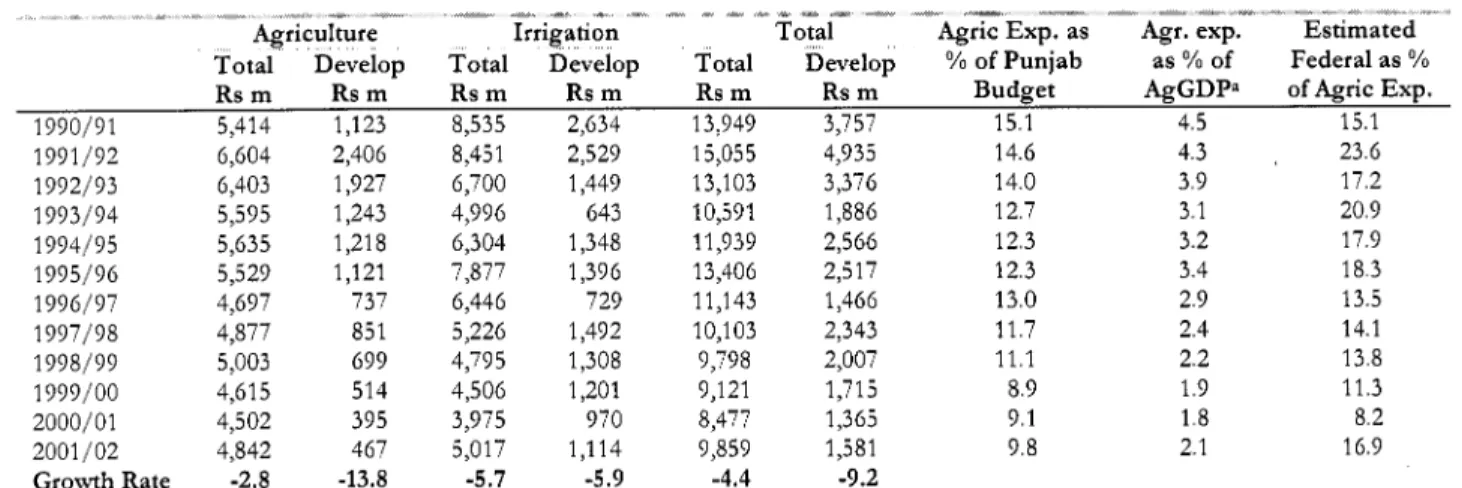March 31, 2005
Document of the World Bank
Report No. 29373-PAKPakistan Punjab Economic Report
Report No. 29373-PAK
Pakistan
Punjab Economic Report
Towards a Medium-Term Development Strategy
Poverty Reduction and Economic Management Unit South Asia Region
Government of the Punjab
Public Disclosure AuthorizedPublic Disclosure AuthorizedPublic Disclosure AuthorizedPublic Disclosure Authorized
TABLE OF CONTENTS
EXECUTIVE SUMMARY ... 7
CHAPTER 1: THE CHALLENGE AND THE ISSUES ... 15
1. 1 CHARACTERISTICS OF INCOME ... 15
1.2 THE POVERTY CHALLENGE ... 18
1.3 CHARACTERISTICS OF THE LABOR FORCE ... 20
CHAPTER 2: PROMOTING JOB-CREATION IN THE NON-FARM SECTOR ... 24
2.1 DEVISING A GROWTH STRATEGY FOR SMALL AND MEDIUM ENTERPRISES ... 24
2.3 STIMULATING FASTER GROWTH IN THE CONSTRUCTION SECTOR ... 35
2.4 IMPROVING THE SYSTEM OF LAND-TITLING IN THE PUNJAB ... 37
2.6 TOWARDS BETTER STRATEGIES TO ACCELERATE GROWTH OF THE SERVICES SECTOR .... 43
CHAPTER 3: ACCELERATING GROWTH IN THE AGRICULTURE SECTOR ... 43
1.4 THE EMPLOYMENT AND GROWTH CHALLENGE ... 21
2.2 IMPROVING THE BUSINESS ENVIRONMENT FOR FIRMS ... 28
2.5 PROMOTING THE DEVELOPMENT OF CITIES AS GROWTH ENGINES ... 39
3.1 RECENT SECTOR PERFORMANCE AND PRIORITIES FOR PUBLIC POLICY ... 43
3.2 RAISING THE LEVEL AND EFFICACY OF PUBLIC EXPENDITURES ... 46
3.3 AGRICULTURAL PRICES AND OUTPUT MARKETS ... 48
3.4 MODERNIZING WHOLESALE MARKETS ... 51
3.5 FACTOR MARKETS FOR LAND AND WATER: ... 54
3.6 UPGRADING THE AGRICULTURE INNOVATION SYSTEM: ... 58
CHAPTER 4: IMPROVING SERVICE DELIVERY AND SOCIAL OUTCOMES ... 63
4.1 THE STATE OF EDUCATION AND HEALTH IN THE PUNJAB ... 63
4.2 THE ROLE OF PUBLIC SERVICES ... 66
4.3 ACCOUNTABILITY OF POLICYMAKERS AND PROVIDERS: ... 73
4.4 THE ROLE OF THE PROVINCIAL GOVERNMENT UNDER DECENTRALIZATION ... 81
4.5 BETTER INFORMATION IS CRITICAL ... 85
CHAPTER 5: IMPROVING PROVINCIAL FINANCES FOR DEVELOPMENT ... 89
5.1 A FISCAL PROBLEM OF A DIFFERENT K~ND ... 90
5.2 ADDRESSING THE PROBLEM ... 95
5.3 MOVING FORWARD ... 101
APPENDIX: A NOTE ON ESTIMATION OF PROVINCIAL GDP: 1990/91-2001/02 .... 105
REFERENCES ... 115
STATISTICAL APPENDIX ... 117
LIST OF FIGURES AND TABLES
T.4BLE 1.1: GROWTH RATE OF REAL GDP: PUNJAB AND PAKISTAN: 1991/92 - 2001/02 ... 16
TABLE 1.2: POVERTY TRENDS: ALL-PAKISTAN AND PUSJAB: 1983/84 - 2001/02 ... 18
TABLE 1.3: EXPENDITURE AND URBANIZATION IN PUNJAB, BY DECILE: 2001 /02 ... TABLE 1.4: POVERTY AND VULNERABILITY IN PUNJAB: 2001/02 ... TABLE 1.5: POVERTY HEADCOUNT RATE: REGIONS OF PUNJAB: 1998/99 - 2001 /02 TABLE 1.6: EMPLOYMENT BY GENDER AND PUBLIC/PRIVATE: 2001/02 ... 20
TABLE 1.7: EMPLOYMENT BY SECTOR, GENDER, AND SIZE OF FIRM: 2001 /o TABLE 1.8: EMPLOYMENT IN PUNJAB BY hhJOR INDUSTRY DIVISION: 1993/ TABLE 1.10: SIZE OF THE CIVILIAN LABOR FORCE IN THE PUNJAB: 1984/85 - 2001/02 TABLE 1.9: CHANGE IN MEDIAN EARNINGS: PUNJAB AND PAKISTAN: 1993/ ... 21
TABLE 2.1: COMPOSITION OF THE EMPLOYED LABOR FORCE IN THE PUNJAB: 1984/85 . 2001/02 ... 24
TABLE 3.1: AGIIICULTUIW, EXPENDITURES IN PROVINCIAL AGGDP: 1990/91 . 2001/02 ... 47
TABLE 4.1: SELECTED EDUCATION INDICATORS FOR PUNJAB AND PAI<ISTAN: 2001 /02 ... 63
TABLE 4.2: hhRGINAL EFFECTS ON THE PROBABILITY OF ATTENDING SCHOOL FORAGES 6-14: 1999/00 .... 67
TABLE 4.3: EDUCATIONAL ENROLLMENTS IN PUNJAB BY CONSUMPTION GROUP: 2001/02 ... 69
TABLE 4.4: DETERMINANTS OF HEALTH STATUS IN PhI<ISTAN: 1990/91 ... 71
TABLE 5.1: PUNJAB FISCAL ACCOUNTS: 19941’95 . 2003/04 ... 89
TABLE 5.2: PUNJAB PROVINCIAL EXPENDITURE . OBJECT CLASSIFICATION: 1999/00 . 2002/03 ... 92
TABLE 5.3: ACCUMULATION OF PROVINCIAL PROVIDENT FUND LIABILITIES: TABLE 5.4: PUNJAB MID-TE~M FISCAL FRAMEWON<: 2002/03-2005/06 1’ ... TABLE 5.5: PROVINCIAL CURRENT EXPENDITURES: 2003/04 - 2006/07 ... 98
TABLE 5.6: MAIN COMPONENTS OF THE PUNJAB GOVERNMENT’S DEBT: 1971/72 - 2002/03 TABLE 5.7: COST AND COMPOSITION OF THE PUNJAB’S OUTSTANDING DEBT: JUNE 2003 ... 99
FIGURE 1.1: COMPOSITION OF GROSS DOMESTIC PRODUCT IN 2001/02: PUNJAB AND PAKISTAN ... 16
FIGURE 1.2: GROWTH-INCIDENCE CURVE FOR PUNJAB: 1984/85 TO 2001/02 ... 17
FIGURE 1.3: UNEMPLOYMENT IN THE PUNJAB: 1984/85 - 2001/02 ... 22
FIGURE 2.1: INVESTMENT OBSTACLES FACED BY FORMAL FIILMS . THE PUNJAB vs . OTHER PROVINCES ... 28
FIGURE 2.2: INVESTMENT OBSTACLES IN THE PUNJAB - FORMAL v s . INFORMAL F I ~ ~ ~ s ... 29
FIGURE 2.3: SOURCES OF WORKING CAPITAL FOR FOR~~AL FIIWS IN THE PUNJAB ... 30
FIGURE 3.1: PUBLIC EXPENDITURES ON AGRICULTURE: PUNJAB v s . OTHER COUNTRIES: 2000 ... 46
FIGURE 3.2. REAL TRANSPORT AND HANDLING COSTS FOR WHEAT IN PUNJAB: 1996/97 - 2002/03 ... 49
FIGURE 3.3: IRRIGATION DEPARTMENT REVENUES AND EXPENDITURES: 1970/71 - 2001 /02 ... 56
FIGURE 4.1: GROSS ENROLLMENT RATES BY PROVINCE: 1995/96 . 2001/02 ... FIGURE 4.3: hfORTALITY RATES OF CHILDREN UNDER 2 M I S . BY HOUSEHOLD FIGURE 4.2: ENROLLMENT RATES IN THE PUNJAB BY INCOME, GENDER. AID ... 65
FIGURE 4.4: FORMATION OF PRIVATE SCHOOLS IN PUNJAB: 1970 - 2000 FIGURE 4.5:PERCENT OF HOUSEHOLDSWHO USUALLYUSE GOVERNMENT HEALTH FACILITIES ... 72
FIGURE 4.6: RELATIONSHIPS OF ACCOUNTABILITY IN SERVICE DELIVERY ... 73
FIGURE 4.7: FRAMEWORK FOR POLICY. PLANNING &BUDGETING IN THE PUNJAB 80 FIGURE 4.8: RELATIONSHIPS OF ACCOUNTABILITY IN DECENTRALIZED SETTINGS ... 82
FIGURE 5.1: TRENDS IN PROVINCIAL PENSION PAYhlENTS: 1990/91 . 2003/04 ... 94
FIGURE 5.2: PROVINCIAL OWN REVENUE: 1994/95 . 2003/04 ... 96
PREFACE AND ACKNOWLEDGEMENTS
This report i s a joint product o f a team from the Government o f the Punjab, the World Bank, the Asian Development B a n k (ADB), and the Department for International Development (DFID) of the Government o f the United Kingdom. In December 2003, the Punjab Chief Minister constituted a counterpart team of government officials, who were closely involved in the report's preparation. This team was headed by Mr. J a h a n p I G a n Tareen, Advisor to the Chief Mlnister Punjab, and Mr. Suleman Ghani, Chairman of the Planning and Development Board, and included the Secretaries of Finance, Planning, Communication & Works, Education, Health, Irrigation, Industries, and Agriculture Departments, and the Punjab Resource Management Program Office.
T h e report was prepared by Salman Zaid~, I a a l i d Ikram, and H a n i d Mukhtar in the Poverty Reduction and Economic Management (PREM) unit of the World Bank's South Asia Region, under the guidance of Manuela Ferro, Lead Economist, Ijaz Nabi, Sector Manager, and John Wall, Country Director. The-team from the Asian Development Bank comprised N a v e d Hamid, Safiya Aftab, and Jacob Gullman. T h e DFID team included Jackie Charlton, H a r o o n Sharif, and M a r k Poston. T h e peer reviewers were Deepak Ahluwalia, Ron Hood, and Farrukh I q b a l (World Bank), and Paul Heytens and Rainer Hartel (ADB).
T h e report draws upon contributions from Rasmus Heltberg (poverty, employment), Shaheen Malik (provincial GDP estimates), Shahid Kardar (construction, land titling, city strategy, and deregulation), Derek Byerlee, Mubarik Ali, Lit-e Ersado, and Asad A l e e m (agriculture), M a r k D u t z and Anton Dobronogov (investment c h a t e ) , Soraya Goga (city strategy), Jeff H a m m e r (service delivery), I<ai Kaiser and I G a l i d Rashid (local government revenue potential), N i c k M a n n i n g and Zahid Hasnain (devolution), Jacob Gullman (background information and overview), and Tim
Wdliamson, Masroor Ahmad, and Samantha Smith (devolution and service delivery in the Punjab).
Muhammad Shafiq, Nasreen Shah Kazmi, Thelma Rutledge, and Shahnaz Rana provided invaluable assistance in handling all logistical arrangements for the mission, and with processing the report.
T h e report team benefited greatly from collaborative work with the Government o f the Punjab counterpart team during three preparation missions (December 2003, February and M a y 2004). T h e counterpart team coordinated all government inputs, and provided comments, feedback, and guidance to the study team at all stages of the analysis and report preparation, and helped facllitate interaction with other line departments. W e are grateful to SMEDA staff for generously making available to the team various recent sector studles and reports. Finally, w e would also like to thank other experts who shared their insights in the course of preparation o f t h i s report, especially Kaiser Bengali, A k m a l Hussain, a n d A.R. Kemal.
EXECUTIVE SUMMARY
1. T h e objective of the report i s to provide an analytical and policy underpinning for the Punjab’s development strategy. Our starting point i s the Government of the Punjab’s enunciation o f the m a i n elements of i t s economic strategy. This strategy will rest on five pdlars: (i) improving governance; (ii) reforming the fiscal and financial management system; (iii) creating a m o r e supportive environment for private sector-led growth; (iv) improving the delivery of public services; and (v) addressing the provincial economy’s vulnerability to shocks.
2. Taken together, these elements add up to a strategy that i s occupied not only with increasing output, but also encompasses items such as education, health, improved governance, and protection of the environment. T h e overriding concern i s to provide a better life for the province’s citizens.
3. In the short- to medmm-term, the provision o f a better life to the Punjab’s citizens depends essentially on two considerations. First, incomes must b e increased; second, the delivery of public services must b e improved.
4. In a market economy, incomes depend mainly upon productive employment, includmg self- employment. Thus, the fivst imperative for the Government o f the Punjab i s to expand the number of jobs. How many jobs will have to b e created? T h e labor force in 2001/02 was 27 d o n , of which an estimated 8.5 percent were unemployed. As a result o f the rapid growth of the population, the labor force in the next decade i s likely to grow at 3 percent per annum, well above the 2.7 percent annual growth registered in the previous decade. I f the objective of the government i s t o m o v e s t e a d y towards “full employment,” which, as in other countries, may b e defined as being consistent with unemployment of 5 percent because of frictional, seasonal, and other such factors, then the Punjab will have to create about one d o n n e w employment opportunities (includmg self- employment) a year.
5. How fast will the economy have to increase in order to create these jobs? In the decade untd 2001/02, an increase o f 1 percent in the estimated provincial gross domestic product (GDP) of the Punjab was associated with an increase o f 0.55 percent in employment. I f the same relationship holds in the future, the GDP o f the Punjab will’have to grow at 6.2 percent a year in real terms. Since the government’s aim i s presumably also to significantly reduce underemployment, a target GDP growth rate o f 7 percent a year would not b e unreasonable.
6. In order that the Government o f the Punjab attains its development objectives, a basic condition i s that the provincial GDP grow at 6-7 percent a year in real terms. This rate i s well above the 4.4 percent a year achieved during the past decade, and will require changes in the institutional and technological framework of the provincial economy.
7. W h a t adds to the challenge i s that the space for action by the authorities to expand employment i s likely to be constricted. While the agricultural sector will undoubtedly remain very important during the next decade, i t i s debatable whether it can provide productive full employment to a substantial amount of additional labor. Moreover, for reasons of efficiency, i t i s clear that the public sector should n o t absorb m o r e labor. Thus the bulk o f the additional employment will have to be generated in the private non-farm sector.
8. In order to draw attention to the necessity o f structural change in the province’s economy, we have treated issues in the development o f non-agricultural activities-such as difficulties faced by
small and m e d m m enterprises in manufacturing and commerce, and the particular problems arising in the construction sector-before we deal with those in agriculture. W e reiterate, however, that agriculture wdl continue to remain crucial as a source o f income and employment and as a generator of demand for the products of the other sectors; we have consequently devoted considerable space to identifying policies that would strengthen the performance o f the agricultural sector.
I. THE NON-FARM SECTOR:
9. T h e private sector employs almost nine-tenths of the workforce o f the Punjab, so if increasing incomes and reducing poverty lie at the heart of the government’s objectives, the m a i n impetus for growth must come from this sector. T h e Punjab private sector encompasses both agriculture and non-agriculture, and the report includes specific recommendations in each of these areas. T h e recommendations call both for reforms to institutions and for increases in allocations for investment.
Improving the business environment for firms
10. Stimulating growth and job creation in the non-farm sector will require significant improvements to the business environment. U n d e r this general rubric, the report provides specific recommendations for actions that are within the control of provincial government, such as those dealing with multiple taxation, labor laws, and regulatory structures:
9 E h n a t e multiple / nuisance taxation that raise the cost o f production.
9 Address weaknesses in labor laws that force many enterprises to remain small, and to hire casual laborers to avoid adverse effects of outdated legislation.
Revamp other arcane regulatory legislation and structures, particularly the provincial Boiler Act, Building and Electricity inspectors, and introduce comprehensive insurance through private parties as an alternative to ensure public safety.
9
Stimulating job-creation in the construction sector
11. Particular emphasis i s paid to the construction sector, w h i c h has a high multiplier effect on employment. T h e Federal Government has recently taken a number o f steps to address one of the biggest problems constraining this sector-the relatively undeveloped state of the housing fmance sector, given the difficulties in enforcing foreclosure laws in the event of a default. T h e Government o f the Punjab can also play a n important role in addressing a number o f other key legal, fiscal, and administrative barriers hindering faster development of the housing and construction sector:
9 Rationalize the stamp duty on property related transactions.
9 Trim change-of-use charge for property classified “commercial” under zoning regulations.
9 Rationalize development charges imposed by local water and sanitation agencies for change o f use of property from “residential” to “commercial.”
Impose a land non-uthzation fee or an idle land tax.
Promulgate a law abolishing the benaami holding of property.
9 9
9 9
Revamp the Rent Restriction Ordinance.
N a r r o w the differential in property tax on renter and owner-occupied property.
Improving the system of land titling
12. L a n d i s a critical economic asset in any country, particularly so for a government seeking to promote the construction sector and provide secure property rights for the most valuable asset owned by households. In order to m o v e towards establishing a m o d e r n land adrmnistration system, with a secure, accurate, and accessible system of registering and recording land transactions, the report recommends that the Government of the Punjab:
9 Initiate pilot projects in two districts of the province for comprehensive cadastral surveys and registration of titles.
Introduce requirement for compulsory registration o f all documents related to property, includmg sale agreements, declaration o f gifts, power of attorney.
Initiate the process of conversion o f presumptive titles into exclusive titles.
9
9
Promoting the development of cities as growth engines
13. An important source o f sustained economic expansion for the province could be the development of cities, supported by industry clusters, as growth engines. In addition to the million- plus cities o f Lahore, Faisalabad, Rawalpindi, Multan, and Gujranwala and their adjoining areas, the Punjab has 10 other cities with over two hundred thousand residents, w h i c h could potentially serve as mini growth-engines for the regional and provincial economy. In some important respects, Sialkot has m e t these condtions, and i t s experience i s used as an illustration in the report. Ideally, 1-2 pilot
cities that display strong potential with respect to the following four dimensions should b e identified for “competitive partnership” initiatives:
9 an organized private sector with entrepreneurs wilhng and able to provide leadership;
9 strong local government support with political will amongst topmost officials;
9 a sponsor with strong credibhty with both private sector and government;
9 instruments such as logistical faciltties and seed funds to start the initiative.
11. PROMOTING GROWTH IN AGRICULTURE:
14. Agriculture i s a major contributor to Punjab’s economy, accounting for roughly 28 percent of i t s output and providmg direct employment to over 40 percent of the work force. While total employment in agriculture has stagnated during the past decade, m o r e efficient uuhzation of the Punjab’s public resources and abundant natural endowments, in combination with measures to promote agricultural &versification away from cereal crops to other m o r e labor-intensive activities, can help unlock this sector’s tremendous employment-generation potential.
Raising the level and efficacy ofpublic expenditures
15. Allocation of public resources to and within the sector i s one o f the major ways that the Government of the Punjab can influence growth and employment generation in agriculture. In order
to reverse the decline in total public expendtures in agriculture as well as improve the composition of public spendng in this sector, the report recommends that the provincial government should:
9 9
Increase public investment, particularly on irrigation, water management, and research.
Reduce the share o f establishment costs out of current expendtures for agricultural support
services, as an important step towards rationalizing public spendng.
Privatize commercial activities, livestock breeding farms and veterinary services, and focus instead on pedigree registration systems, capacity building and strengthening o f private breeder associations, and control of livestock dsease epidemics.
I m p r o v e cost recovery, especially through greater cost recovery for canal maintenance in conjunction with devolution to water user associations.
9
9
Rationalizing the wheat procurement and storage policy
16. In recent years, even the sum total o f expendtures by the Department of Agriculture in the Punjab have been overshadowed by the subsidy provided by the provincial government to one crop-wheat. T h e stated intention o f the government’s intervention in the wheat market i s to address deficiencies in private markets, but a consistent policy has yet to b e developed. While there may b e justification for interventions to mitigate the adverse effects of undue volathty in the price of wheat, the report notes that i t i s important for the provincial government to:
Clearly establish the objectives and targets for intervention in wheat markets by laying out a framework for intervention that defines a tolerable level of price variablltty, minimizes fiscal outlays, minimizes dstortions to long-run market equilibrium prices, maximizes private sector participation and competitive markets, and ensures that the poorest are the major beneficiaries of fiscal expenditures.
Implement the foregoing policy in the short-term by exploring competitive tendering of procurement and storage by the private sector, setting the margin for procurement and issue prices to cover full costs, and developing mechanisms for targeting subsides to the most vulnerable groups.
Develop a policy for public involvement in wheat markets over the longer term only in extreme situations.
Modernizing wholesale markets
17. An efficient marketing system i s a prerequisite for agricultural &versification, as i t allows farmers to m o v e away from production of cereals and other relatively low-value crops to those that command the highest return in the market place. Wholesale markets in particular play a critical role in this regard, as they help connect rural production areas to urban consumption centers. Despite the importance o f agriculture in the economy of the Punjab, development of wholesale markets has not kept pace with the needs of the province. Market infrastructure tends to b e biased towards major crops rather than livestock, fruits, vegetables, and other such high-value crops, the market information system i s poorly developed, and the adrmnistrative structure to regulate output markets i s highly bureaucratic and lacks effective private sector participation. T h e G o v e m m e n t o f the Punjab can take a number of steps to address these shortcomings:
Implement the planned r e f o r m of market regulations through amending the 1938 Market Committee A c t to encourage private sector participation and investment to modernize markets.
I m p r o v e the market information system through revamping the district-level market information system, and develop information packages to promote export of horticultural products.
Develop in collaboration with the private sector, critical infrastructure such as refrigerator bogies, c o l d storage facilities at major airports, and state-of-the-art laboratories for f o o d safety testing.
Establish minimum grades and standards for all agricultural r a w and processed products for the domes tic market, aiming to have the equivalence of WTO-recognized Codex Alimentaritts standards for export markets.
Invest in capacity building for food testing, and involve producers and exporters in implementing food safety management systems.
Improving functioning ofland and water markets
18. Well-functioning input markets for land and water also have a very important role to play in encouraging the m o v e towards m o r e efficient, equitable, and competitive farms. To this end:
9 An effective land recording system would promote the smooth transfer of titles and an efficient land market. L a n d taxes based on the size o f the land holdings should b e set to reflect productivity potential, and discourage underuthzation of land on large holdings.
I m p r o v e d water-use efficiency requires better maintenance, rehabhation, and modernization of the irrigation and drainage system. Increased public investment i s needed even to maintain current efficiency levels.
T h e gap between water supply and demand d persist unless there i s a m o v e towards higher water productivity through substitution towards high value water efficient crops such as fruits and vegetables.
Sustainable water use requires an integrated approach to the use of surface and groundwater along with appropriate pricing mechanisms that reflect the scarcity of water.
9
9
9
Benefiting from innovation
19. Finally, a strong agricultural innovation system i s critical to modernizing agriculture, as a large part of future productivity gains, quality enhancement, and diversification must b e provided through
generation, adaptation, and dissemination of n e w technologies and information. T h e report recommends that a comprehensive approach be taken by the provincial government to tackle the key
policy reforms needed to modernize the agricultural innovation system in the Punjab:
9 Establish a competitive fund to support high priority research, providing operating costs to research by allocation on a competitive basis through a small high quality apex research board.
Improve the enabling environment for private and public sector innovation by lobbying the Federal government to urgently approve plant varietal protection (PVP) laws and appropriate bio-safety regulations.
9
9 Develop a h u m a n resource and incentive framework for quality research through merit-based recruitment, abolish promotions based solely on available posts, and instead develop a career service stream based o n well-defined promotion criteria that stresses qualifications and accomplishments.
D e f i n e the role of the provincial extension staff within a decentralized system, especially focusing on human resources development and knowledge sharing among districts.
9
111. IMPROVING PUBLIC SERVICE DELIVERY:
20. T h e second aspect o f providing a better life for the Punjab’s citizens i s improved delivery of public services. Primary education i s better and health status i s worse in the Punjab relative to other provinces in Pakistan. However, both are s t d l worse than countries with the Punjab’s level of income.
Further, they have changed m o r e slowly than would b e expected given the rate of economic growth in the province. T h e role o f public services in determining social outcomes i s unclear, as there i s an astoundmg lack of relevant information that would make this determination possible.
21, U n d e r the ongoing devolution initiative, local govemment nazimeen are now the principal policymakers with regard to many key economic and social services. In order for local elected officials to discharge their n e w responsibhties effectively, they need to understand, act upon, and b e accountable to, the desires of the public-particularly poorer people. Better information i s thus
critical to both better policy decisions as well as better accountability. T h e public should know what it i s entitled to receive and what i t i s actually receiving relative to government policies and relative to other communities. For their part, local governments need to know the effects o f policy on the ultimate goals. This requires information on inputs in a form that can b e matched to outcomes.
22. T h e role of the provincial government does not disappear with decentralization but needs m o r e clarity to avoid overlapping and ambiguous responsibhties. For example, the provincial government i s essential for particular functions, such as those with cross-border or large-scale effects. Further, the
provincial government has a very important role to play in helping to improve the accountability of local governments to their clients by generating and publicizing information to facllitate both learning across districts and accountability to electorates.
9 Attention to better health and education outcomes, not j u s t better internal processes of government offices, i s needed for improved service delivery. Providers in the public sector should be held accountable for improved outcomes.
Given a large and growing private sector in both health and education, public policy must complement rather than substitute for the private sector. I n f o r m a t i o n needs to b e collected on outcomes-enrollment rates or educated children, health status and coverage o f safe water-for the whole population, not just those using public facilities.
As local governments experiment with alternative strategies for delivery o f economic and social services, i t i s important to monitor these various n e w initiatives, and evaluate carefully what works and what doesn’t.
9
9
Iv. IMPROVING PROVINCIAL FINANCES FOR DEVELOPMENT:
23. To achieve i t s employment, growth, and service delivery goals, the Government of the Punjab d need to significantly improve the state of i t s public finances. On the face of it, the provincial government’s aggregate fiscal position appears to b e reasonably satisfactory, with fiscal deficits during the 1990s averaging less than 1 percent of provincial GDP, lower than those typically run by sub-national governments in other federal systems across the world. However, in order to achieve i t s ambitious development goals, the provincial government d need to mobdize additional revenues to finance the cost of providmg high-quality economic and social services, and deepen budgetary and financial reforms to enhance the effectiveness of existing expenditures. Unless suitable measures are taken to address this potential problem, liabdities arising employees’ future pension payments may pose a major financial problem for the provincial government.
24. T h e report includes recommendations on several promising sources to increase own-revenues, as well as various steps needed to strengthen provincial tax administration. Establishing provincial finances on a flrmer footing in turn d help create the additional fiscal space needed to improve public infrastructure and service delivery in the province. T h e process of using a medium-term budget framework introduced by the Government of the Punjab in i t s 2003/04 budget should b e expanded to gradually cover all provincial expenditures. A key element in deepening this process will be to do away with the bifurcation o f the budget into development and recurrent components.
T h e agricultural income tax’s structure and administration should b e i m p r o v e d by using cropped rather than cultivated area as the taxable unit, lowering tax threshold on irrigated farms, and reducing tax avoidance by prohibiting benaami transactions.
T h e urban immovable property tax should b e improved by reducing the differential in assessment rates for renter vs. owner-occupied properties and rationalizing remaining exemptions. T a x data-bases should b e updated using better census and survey techniques so that all properties are enumerated a n d their rental value properly assessed.
T h e government should consider promulgating a provincial fiscal responsibfity l a w on the pattern of the Federal Government, as well as improve financial accounting and reporting.
T h e provincial government’s p l a n to streamline and modernize the tax administration machinery by merging the provincial B o a r d of Revenue and Excise and Taxation department should b e pursued with full vigor.
v. IMPLEMENTATION CHALLENGES AND FURTHER WORK O N T H E STRATEGY
25. Several recommendations presented in the report are not necessarily new; indeed some have been well-researched and known for many years. Nevertheless, because o f a variety of political- economy and other institutional constraints, they have not been acted upon earlier. T h e present provincial government has demonstrated i t s willingness to embark upon a comprehensive program of economic and structural reforms to improve the quality o f life of i t s people. I t has prepared a Poverty Reduction Strategy Paper outlining the m a i n objectives o f i t s development strategy, and has initiated ambitious reforms o f provincial finances and the education sector with financial and technical assistance from development partners. During the past f e w years the Federal Government has undertaken extensive reforms to help correct macroeconomic and fiscal imbalances, and i s now increasingly focusing i t s efforts to address m o r e deep-seated structural issues and constraints
impeding faster economic growth. T h e prevaihng economic situation in Pakistan thus provides the provincial government with a particularly favorable environment in w h i c h to augment i t s ongoing reform effort.
26. In translating i t s good intentions i n t o reality, an important challenge for the provincial government wdl b e to tackle the capacity and institutional constraints that have hindered earlier efforts. In a d l t i o n to strengthening the existing system o f financing, over the m e d i u m t e r m the provincial authorities must develop other innovative methods to bridge the likely shortfall between i t s investment needs and resources. With the growing emphasis on decentralization, i t i s inevitable that there wdl b e changes in the scope and manner of managing the provincial economy. In addition to i t s present role, the Punjab government will become increasingly involved in the type of economic management that can best b e described as “macroeconomic”. W e understand, o f course, that macroeconomic management for a province l f f e r s in significant respects from that for the country as a whole. T h e provincial government i s not the prime m o v e r in a number of key areas of macroeconomic policy, such as tax policy and interest rates. Nevertheless, the provincial authorities must s d l monitor the impact of central government policies on the provincial economy. Moreover, the coordination o f policies with the central government can b e m o r e effective if the effects of central government policies on the provincial economy can b e described in a quantitative manner.
27. A sine qua non for managing the economy on these expanded lines i s the development of a suitable database and o f institutions that provide the required analytic expertise. In this report, we recommend the compilation of a database that would cover the m a i n indicators, such as the provincial GDP, investment, savings, flows of credit, employment, industrial production, and so on.
I t d also require reliable information o n the informal sector, w h i c h provides so m u c h of the
employment to the Punjab’s labor force, and on the impact of economic policies, both central and provincial, o n the S M E sector. T h e government should also strengthen the capabiltties o f the Planning and Development Department, the Finance Department, and provide greater analytic
support to all other departments, either by developing in-house capacity, or by strengthening external research institutions such as the Punjab Economic Research Institute.
28. Another major area in w h i c h information must be collected and a program o f work developed relates to city clusters. A strategy must be formulated whereby the many large and m e d i u m cities in the Punjab can b e developed into growth-poles, and not for economic reasons alone. An urban strategy for the Punjab should a i m at the development of several “livable” cities, w h i c h in a d d t i o n to economic possibhies offered substantial opportunities for social and cultural growth. This would be in the spirit o f decentralization and local empowerment, and would also prevent a situation arising in which Lahore became the overwhelming, if not the sole, magnet for population migration while the other urban centers withered.
29. To sum, considerable additional work d need to be done in order to operationalize the government’s vision for the Punjab. T h e present report should therefore b e regarded as a contribution to work in progress that will be continued in the coming months. I t i s intended to b e an
input into the process o f deliberations undertaken by the provincial government team to decide the appropriate sequencing of the recommended measures under i t s r e f o r m program. T h e report team stands ready to provide whatever a d l t i o n a l technical assistance m a y b e needed by the provincial government for this purpose.
